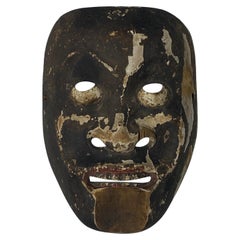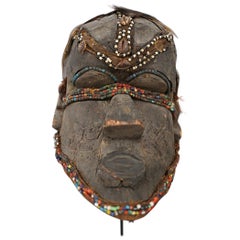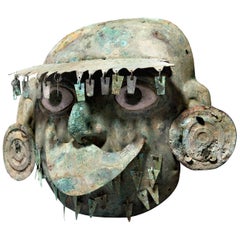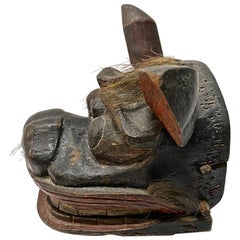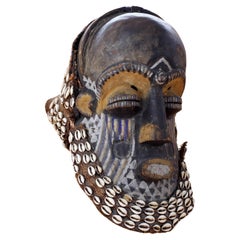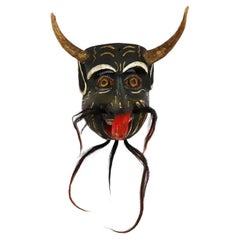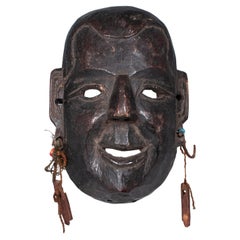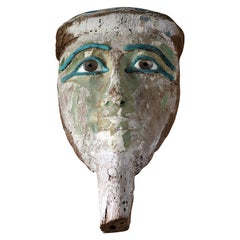18th Century and Earlier Masks
to
1
2
1
7
7
21
218
13
46
89
35
4
2
3
4
13
19
21
4
4
4
3
2
1
1
3
2
2
2
2
7
7
7
Period: 18th Century and Earlier
Japanese Antique Edo Hand Carved Wood Noh Theater Mask Otobide 17th-18th Century
Located in Studio City, CA
A truly beautiful, wonderfully aged, alluring mask made for Japanese Noh theater. The naturally faded beauty and unique character drew us to this mask immediately.
The mask is handcrafted and hand-carved from natural wood, clearly by a master of his trade.
We believe this mask is of the Noh theatre character Otobide.
This mask dates back to the Edo Period (1603-1868). It comes with a wooden storage box (which may have been added at a later date).
A rare, unique, and exquisite mask. Finely carved and executed. Would be a great addition to any Japanese or Asian art/artifacts collection or an eye-catching stand-alone accent piece in about any setting.
Mask dimensions: 7.7" high, 5.7" wide, 2.1" deep...
Category
Japanese Edo Antique 18th Century and Earlier Masks
Materials
Wood, Lacquer, Paint
Kuba Mask African Bwoom Tribal Congo in Wood, Vibrates Vegetables, Animal Hair
Located in Milano, IT
The African Kuba Bwoom tribal mask is the oldest known mask, the Kuba bwoom mask. The materials used for the realization of the Mask are: Wood, colors and vibrates plants, caures, beads, animal hair. In dance it expresses exuberance and joy. The style is similar to that of the middle Kasai. This mask is a helmet with animal hair, carved with a very wide forehead and hollow cheeks that are announced by motifs or dashes and beads. The mouth of the mask is very pronounced carved in wood and then applied on the mask. To distinguish the forehead in different areas are used black and white beads to draw attention to other aspects of the face such as the nose and chin. The entire edge of the chin is surrounded by beads of various colors. The person wearing the mask cannot look because there are no holes for the eyes present; the mask must create the feeling of being blind. Some masks similar to the bwoom mask include the funny mask, the ram mask and initiation masks such as Nnup.
The real Kuba masks...
Category
Congolese Tribal Antique 18th Century and Earlier Masks
Materials
Animal Skin, Organic Material, Wood
$2,866 Sale Price
20% Off
Moche Copper Bronze Mask
Located in San Pedro Garza Garcia, Nuevo Leon
A large coper mask of a dignitary with almond shaped, inset shell eyes with pupils and a wide brim type crown. Attached at the brow line, a row of danglers is suspended, aligning the...
Category
Peruvian Pre-Columbian Antique 18th Century and Earlier Masks
Materials
Copper
$18,750
Noh Edo Period Lion Mask II
Located in Pasadena, CA
This another superb example of an Edo Period early 18th century or earlier Lion Mask created for the Lion Dances of the Gion Matsuri Festival. The mask is i...
Category
Japanese Edo Antique 18th Century and Earlier Masks
Materials
Wood
Egyptian Mummy Mask, Late Period, ca. 700-30 B.C.
Located in San Pedro Garza Garcia, Nuevo Leon
Carved hardwood mummy mask having a pink-brown painted ground, painted black eyes and brows. Wearing a black headband. Eyes and brows are restored. Scattere...
Category
Egyptian Antique 18th Century and Earlier Masks
Materials
Hardwood
Pre-Columbian Chimu Gold Mask With Scar
Located in San Pedro Garza Garcia, Nuevo Leon
A large sheet gold mask depicting a stylized human face having an individually fashioned and applied nose. Large low relief repousse eyes and rectangular mou...
Category
Peruvian Pre-Columbian Antique 18th Century and Earlier Masks
Materials
Gold
Pre-Columbian Funerary Gold Mask with Royal Turquoise Beads in its Eyes
Located in San Pedro Garza Garcia, Nuevo Leon
A high karat heavy sheet gold human face mask with large almond-shaped eyes and recessed pierced pupils. Multiple small perforations along the upper and lower edges for attachment. L...
Category
Ecuadorean Pre-Columbian Antique 18th Century and Earlier Masks
Materials
Gold
Related Items
Kuba Mweel Mask
Located in Austin, TX
"Residing in the Democratic Republic of Congo, the Kuba people are true artisans whose craftsmanship fueled traditional rituals, performances, and storytelling. Natural materials, in...
Category
Congolese 18th Century and Earlier Masks
Materials
Shell, Burlap, Wood
Antique Mexican Demon Mask
Located in Mexico City, CDMX
We offer this rare antique Mexican Demon mask in wood, circa 1970. The mask makes a sound when moved.
Category
Mexican Folk Art Vintage 18th Century and Earlier Masks
Materials
Wood
Antique Mexican Diablo Mask
Located in Mexico City, CDMX
We offer this rare and very antique Mexican Diablo mask in wood, circa 1940. Great patina.
Category
Mexican Folk Art Vintage 18th Century and Earlier Masks
Materials
Wood
Hand-Carved Wood Javanese ‘Wayang Topeng’ Theatre Mask, Indonesia c. 1900
Located in Jimbaran, Bali
A visibly old mask from the Javanese masks theatre ‘wayang topeng’: carved from hard wood, and painted on the front side. The mask shows clear traces of ...
Category
Indonesian Other 18th Century and Earlier Masks
Materials
Wood
$1,200 Sale Price
20% Off
H 9.85 in W 8.27 in D 4.73 in
Japanese Carved and Lacquered Wood Shogun, Edo Period, 19th Century, Japan
Located in Austin, TX
An unusual Japanese carved wood, lacquer, and gilt decorated portrait sculpture of a shogun, Edo Period, early 19th century, Japan.
The unidentified shogun (possibly Tokugawa Iey...
Category
Japanese Edo Antique 18th Century and Earlier Masks
Materials
Wood, Lacquer
$2,800
H 10.25 in W 10.5 in D 7.5 in
Peru Pre Inca 100-700 Ad Moche Pre Columbian Personified Vessel in Earthenware
Located in Miami, FL
Rare pre Hispanic Moche culture, pre-Inca earthenware vessel.
A beautiful interesting piece, created in the southern Peru region around the 100-700 AD by the Moche culture. This rare early period...
Category
Peruvian Pre-Columbian Antique 18th Century and Earlier Masks
Materials
Earthenware, Pottery
$1,645 Sale Price
30% Off
H 8.75 in W 5 in D 4.25 in
Expressive Early Classic Cubist Dan Mask Early 20th Century Liberia, ex Sothebys
Located in Point Richmond, CA
Expressive early classic cubist Dan mask with refined expressive look, narrow open eyes and mouth and fine line scarification marks around outside of face. Created early 20th century by the Dan People...
Category
Liberian Tribal 18th Century and Earlier Masks
Materials
Wood
$9,500
H 9.5 in W 5.75 in D 3.75 in
Pre Columbian Calima vessel Columbia ancient South America
Located in London, GB
Pre Columbian Calima vessel Columbia ancient South America
A Calima vessel featuring double spouted stirrup vessel with incised design in red clay
Calima circa 200 BC- 400 AD Col...
Category
Colombian Antique 18th Century and Earlier Masks
Materials
Clay
Nocturnal Bird Mask, Nigeria, Africa, circa 1950
Located in San Pedro Garza Garcia, Nuevo Leon
Very beautiful mask with large pronounced eyes with the circular cavity shape. The mask depicts a nocturnal bird that can see in the darkness and manifest the presence of divinities ...
Category
Nigerian Tribal 18th Century and Earlier Masks
Materials
Wood
Pre Columbian Colima Dog Ancient West Mexico Latin American Antiques Art
Located in London, GB
Pre Columbian Colima Dog Ancient West Mexico
Pre-Columbian, West Mexico, Colima Ancient Mexico C 200 BC –400 AD
A attractive seated Colima dog v...
Category
Mexican Antique 18th Century and Earlier Masks
Materials
Pottery
$1,307
H 10.63 in W 12.6 in D 7.09 in
Nepal Citipati Wood Dance Mask with Open Eyes Mouth Teeth, Black Skull Mask
Located in Point Richmond, CA
Oval wood dance mask from Nepal with powerful expression, open eyes and oval mouth with finely carved teeth. Heavy projecting cheek bones. This mask represents the Tibetan and Nepal...
Category
Nepalese Tribal Antique 18th Century and Earlier Masks
Materials
Wood
$3,950
H 8 in W 6.5 in D 3 in
Pre Columbian Large Jalisco Figure West Mexico Circa B.C. 100-300 A.D
Located in London, GB
A Pre Columbian Jalisco warrior figure
Jalisco West Mexico circa B.C. 100-300 A.D,
A stunning large pottery warrior figure wearing a banded headdress with disco arm ornaments , ...
Category
Mexican Antique 18th Century and Earlier Masks
Materials
Pottery
$1,307
H 17.33 in W 11.03 in D 7.09 in
Previously Available Items
18th-19th Century Mask, Arunachal Pradesh, Eastern Himalayas, India
Located in Point Richmond, CA
Mask, Monpa-Sherdukpen people, Arunachal Pradesh, India
A mask from the Monpa/Sherdukpen people of Arunachal Pradesh, which is thought to be a monk or one of the sons of Apapek. I...
Category
Indian Tribal Antique 18th Century and Earlier Masks
Materials
Wood
Wooden Mask with Rock Crystal Eyes and Bronze Eyelids/Eyebrows
Located in San Pedro Garza Garcia, Nuevo Leon
Wooden mask with rock crystal eyes and bronze eyelids/eyebrows
Circa: 711-332 BC
Origin: Egypt.
Category
Egyptian Antique 18th Century and Earlier Masks
Materials
Stucco
Japanese Okame Ko-Omote Noh Theater Mask Edo Period
Located in Studio City, CA
A truly beautiful, wonderfully aged, alluring mask made for Japanese Noh theater. The natural faded beauty and unique character drew us to this mask immediately.
This mask is handcrafted and carved from natural wood and lacquer.
Ko-omote translates as "little mask" or sometimes "small face." This particular delicate featured mask (her red lips really stand out) is used for main and sometimes secondary roles when the character is a young girl or, in some cases, a supernatural being. What is also interesting about this mask is that remnants of the blackened teeth can still be seen. Centuries ago, it was customary for Japanese women to paint their teeth black after they were married.
We believe this mask dates from the mid-late Edo period and thus quite rare. The mask was acquired from an antique mask...
Category
Japanese Edo Antique 18th Century and Earlier Masks
Materials
Wood, Lacquer
Japanese Court Dance Mask / Bugaku, circa 1800
Located in Point Richmond, CA
Japanese Court dance mask / Bugaku, circa 1800
This mask was used in a form of traditional court dance known as bugaku during the end of the 18th and early 19th centuries. Traditi...
Category
Japanese Edo Antique 18th Century and Earlier Masks
Materials
Gesso, Hardwood
Bamana Mask "Ntomo", Mali, Africa, circa 18th-19th Century
Located in San Pedro Garza Garcia, Nuevo Leon
Very old African wooden mask with brown patina, resin-like mass with nassa snails on the five tooth-like projecting horns, minor missing parts (chin, nose) and snails, traces of insect caused damage.
This beautiful piece comes with a custom-made stand.
According to Robert Goldwater, former director of New York’s now-defunct Museum of Primitive Art (MPA), He describes Ntomo face masks as "among the most interesting of the Bambara [or Bamana] masks." He recognizes formal variety in the carving of Ntomo face masks, but he also specifies that an "oval shaped human face surmounted by a high comb of vertical spikes or horns" distinguishes Ntomo face masks from other types of face masks.
Research indicates that the Bambara mask...
Category
Malian Tribal Antique 18th Century and Earlier Masks
Materials
Wood
Antique Japanese Noh Theatre Mask, Edo Period, 18th Century
Located in Prahran, Victoria
Antique Japanese carved and lacquered Noh Theatre mask on stand, Edo period, 18th Century.
Dimensions: H 21 cm x W 14 cm x D 8 cm.
Category
Japanese Edo Antique 18th Century and Earlier Masks
18th Century Carved Chinese Qing Heads
Located in Buffalo, NY
Monumental carved wood Chinese Qing Dynasty (1644-1911). Head of a Luohan (or Arhat) exceptional carving, black glass eyes custom iron stands.
Category
Chinese Tribal Antique 18th Century and Earlier Masks
Materials
Glass, Wood
Egyptian Late Kingdom Sarcophagus Mask
Located in New Orleans, LA
This amazing wooden sarcophagus mask is a stunning relic from Ancient Egypt. Originally part of a sarcophagus that was meant to forever protect the mummy of the deceased, this enigmatic face hails from the 26th Dynasty of the Late Kingdom. It is carved from a single piece of cedar and bears the original light ocher and black paint, representing the kah, or the image or immortal spirit double of the deceased. Once the mummy was in the sarcophagus, a life-sized image of the deceased was placed over his face. Wooden pegs were used to keep the wooden pieces in place, and the mask was then gessoed and painted with life-like features of hair, eyes, lips and facial color. Such masks were in use well into the Greek Ptolemeic period around 300 B.C.
Masks were a very important aspect of ancient Egyptian burials. In the Egyptians' complicated view of life after death, they provided the dead with a face in the afterlife and enabled the person's spirit, or ba, to recognize the body. Specific features of a mask, including the eyes, eyebrows, forehead and other features, were directly identified with individual divinities. This allowed the deceased to arrive safely in the hereafter, and gain acceptance among the other divine immortals in the council of Osiris, the great god of the dead. Initially made for only the royalty, such masks were later frequently crafted for the nobility. They were also part of the elaborate precautions taken by the ancient Egyptians to preserve the body after death. The protection of the head was of primary concern during this process. Thus, a face covering...
Masks were a very important aspect of ancient Egyptian burials. In the Egyptians' complicated view of life after death, they provided the dead with a face in the afterlife and enabled the person's spirit, or ba, to recognize the body. Specific features of a mask, including the eyes, eyebrows, forehead and other features, were directly identified with individual divinities. This allowed the deceased to arrive safely in the hereafter, and gain acceptance among the other divine immortals in the council of Osiris, the great god of the dead. Initially made for only the royalty, such masks were later frequently crafted for the nobility. They were also part of the elaborate precautions taken by the ancient Egyptians to preserve the body after death. The protection of the head was of primary concern during this process. Thus, a face covering...
Category
